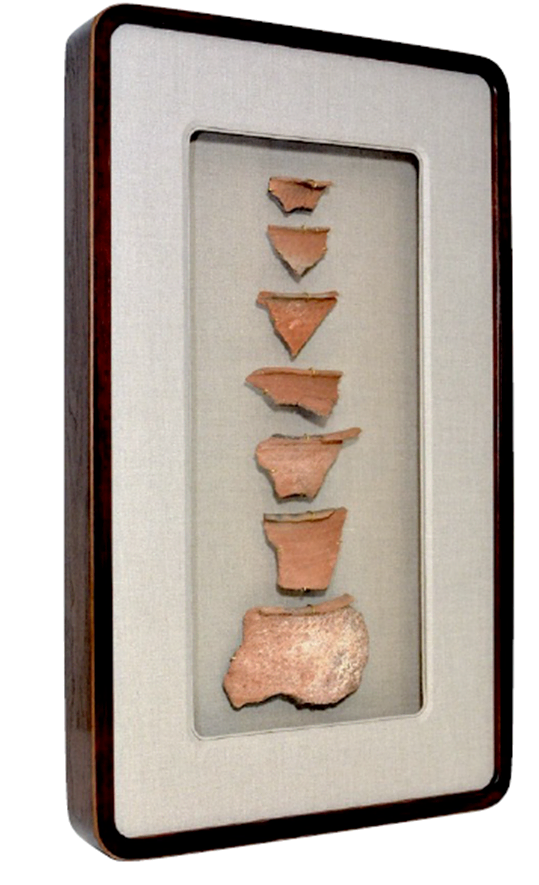There may be nothing more exciting for a custom framer than when a customer project presents a challenge that requires a truly creative solution. This was the case for me with a recent request to showcase and protect one of my customer’s collection of antique pottery shards.
The design
My intention for each framing component was to have a supportive purpose either through structure or visual emphasis. The techniques and materials required for designing an environment that best displays and preserves something like antique pottery shards are not found in a book. The first step was to determine what format would highlight the unique characteristics of each piece, and I chose to arrange the shards vertically with the largest at the bottom and the smallest at the top to achieve balance. The challenges became progressively complex from there.

Though I have been in the industry for decades, this project had some elements that I had not encountered before. One element, in particular, was the mounting of the pottery pieces. Because this was an archival project, it was essential that the pieces could be removed without damage, if necessary or desired. My solution was inspired by the design of a diamond ring. Each shard is cradled in a set of prongs fashioned out of brass tubing, pulled through the center of a 2” dowel and bent around the edge of the pieces on all sides. The tubing and dowel are attached through holes in the backing that are affixed with screws. To make the dowels as subtle as possible, I wrapped them in the same linen fabric as the backing and liner.
The creation of balance
With such depth to the display, I needed a way to create balance with the dimensions. My solution was to add a liner that sits above the pottery just below the glazing to create a space around the pottery shards and provide a generous border to give the whole piece breathing room. This MDF-board liner is wrapped in the same earthy linen as the mounting board and spacer frame that sits between the two. A matching flexible fillet gives a finished look to the perimeter of the beveled liner. The linen achieves the right balance of color and texture that complements the terracotta tones and roughness of the shards.
The frame was crafted from Eastern FAF-Grade Black Walnut, a beautiful type of wood known for its strength and durability, the ideal material to use for pottery that has endured the test of time. Hand finished with a custom mixed rich brown stain, the frame features rounded corners that mimic the rounded edges of the shards. Because the width of the face edge seemed too wide to me at first, I added a 45-degree bevel to the outer edge. Fortunately, this worked in my favor, as the frame was already finished before this step occurred to me. The hint of the bare wood color that is revealed enhances the visual interest of the piece overall by complementing the natural tones of the pottery.
The glazing
For many reasons, I chose Optium Museum Acrylic® for the glazing. With a complex shadowbox assembly project, such as this one, the importance of its static-resistance cannot be stressed enough. The value of the items being framed, such as antiques and personal treasures, deserved the highest degree of conservation. The visual character of the subject and the depth of the framing package required the highest degree of clarity. Optium Museum Acrylic offers both, with its 99% UV protection and anti-reflective properties. It is also scratch and shatter-resistant.
Though this piece was part of a customer project, I was encouraged to enter it into the PPFA International Framing Competition’s Open Category, and it won. Even more importantly, it gave a great amount of satisfaction of being able to create a display that preserves something that means so much to a customer in a way that they can enjoy for a lifetime.
Share this Article:
This article is intended for educational purposes only and does not replace independent professional judgment. Statements of fact and opinions expressed are those of the author(s) individually and, unless expressly stated to the contrary, are not the opinion or position of Tru Vue or its employees. Tru Vue does not endorse or approve, and assumes no responsibility for, the content, accuracy or completeness of the information presented.
